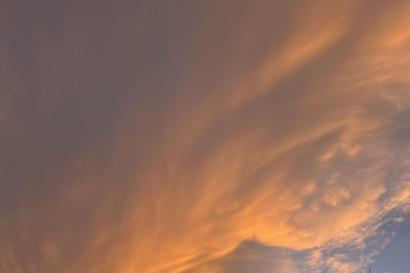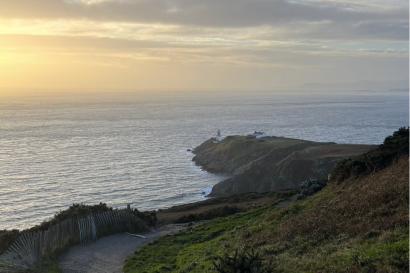In primary and secondary school, I learned about the Berlin Wall. I learned about the atrocities of the World Wars, the violation of human rights by various government regimes, and even the internment of Japanese-Americans in my own nation. What I never learned about - even though a violent, devastating period that received international attention - were The Troubles in Northern Ireland.
Seeing first hand the remnants of a thirty year guerilla war was not one of the glamorous trips you might expect from studying abroad, but one that was deeply touching, unsettling, and entirely unforgettable. I’ve been reflecting on the trip my Northern Irish Troubles class took to Belfast a few weeks ago, hoping to gain a better understanding of a culture that still bares deep scars from decades of entho-sectarian violence.
When you arrive in Belfast, it looks like most other European cities on the main streets: there are churches, shops, pubs, and hotels. Then, you begin to see the mismatched Peace Walls that separate Catholic and Protestant communities. You see the gates that close at 7 p.m. each night, that do not reopen until 7 a.m. the next day.
As we walked through the city, our professor stopped us in front of the Europa Hotel, dubbed “the most bombed hotel in Europe.” It survived 36 bombings. No one was killed during any of the attacks: our professor pointed out that the rebuilding and bombing of the hotel by the Irish Republican Army (IRA) became almost symbolic.
Our first tour guide was a Catholic Nationalist who was imprisoned for ten years during internment in Northern Ireland. As we stood in front of a mural of Bobby Sands, our guide described his experience during the blanket protests and hunger strikes.
Families, he said, had difficult decisions to make during the hunger strikes. When a prisoner fell into a coma, decisions on the individual’s care fell into the family’s hands: did they take their loved one off the hunger strike and hope they lived, or respect their dedication to the cause and allow their body to be starved?
We walked along Bombay Street near where our guide grew up. Walking along a high Peace Wall, we could see the three segmentations marking each time the wall was raised. We stopped in a memorial, almost flush to the wall, and our guide pointed out the names of individuals he knew, recounting stories of growing up in an area teeming with IRA activity. He walked us through the gates between the Catholic and Protestant side, and shook hands with our next guide.
Our second guide was a soldier in the British Army during the Troubles: he detailed the Protestant/Unionist side of the struggle as we walked along the wall on Cupar Way, 1.2 kilometers long and a meter thick. Our guide explained the deep fear still held by communities on both sides: the people support the wall, fearing the violence that could break out, especially at night, if the wall were to be taken down or the gates left open any later.
Our professor brought markers, and each of us added our signatures to the overlapping scrawls on top of painted work. Some paintings were political, some were intricate murals, and others were simply spray painted names or words. As a young American with limited knowledge of or stake in the struggles between the two sides, I was struck by how many visitors must sign the Protestant side each year, simply because the wall is so accessible there.
Our guide stopped us outside of a shop on Shankill Road where an IRA bomb once killed ten people. He had heard the bomb detonate and ran to help pull people out of the rumble. He found the youngest victim, a two year old girl missing her limbs, and wrapped her body in his coat before assisting more people. He brought us to two outdoor memorials, with photos from bombings and violence in Belfast and around the world.
Seeing all of this, from an outsider’s perspective, exactly two decades after peace was supposedly reached, was a very strange experience. Both of our guides were intelligent, passionate, and have experienced more than any of us students ever will. However, my classmates and I discussed that so much of what we heard and saw felt like propaganda, even the memorials. The nationalist stance and unionist stance are both sympathetic and emotional causes, but it can be difficult to articulate each side’s reasons for continued violence and relationation in the face of so much destruction. We saw a stark bitterness and blame on both sides - understandably so - that helped us better understand the continued animosity between the two groups.
Our guides both explained how Protestant and Catholic children grow up in entirely segregated primary and secondary schools, only meeting each other once they move on to college. They explained how, as adults, Catholics only socialize with Catholics, and Protestants only socialize with Protestants. During the day, the two communities will cross sides to go to work, to go to the doctor or the dentist, but each night a siren goes off and the gates close. Each community is extremely close knit, and strangers are met with great suspicion.
The thought of having a wall closing off entire portions of a city is, personally, a little hard to grasp. America has not fought a war on our land in my lifetime, nor the lifetime of my parents or grandparents. I was too young to remember the 9/11 attacks, although I do know the fallout from it. Coming from a land of relative peace, it was very disorienting to see the fallout of modern warfare is such a small area over such a long period of time, and the effects, on both the people and landscape, that are still being addressed today.

Madison Weaver
<p>My mother is a professional photographer, instilling in me a life-long love of photography and visual art. Assisting in her studio since I was fourteen, I've learned to capture landscapes and people in unique ways. I am a creative writing merit scholar at Bucknell University, where I have found my passion in nonfiction writing and honed my writing and editing skills as a news editor for the student run newspaper. Inspired to combine my passions for the literary and the visual, I took the initiative to create an interdepartmental Multimedia Communications major, utilizing the design, marketing, and business expertise on campus to expand my passion for sharing and communicating.</p>









